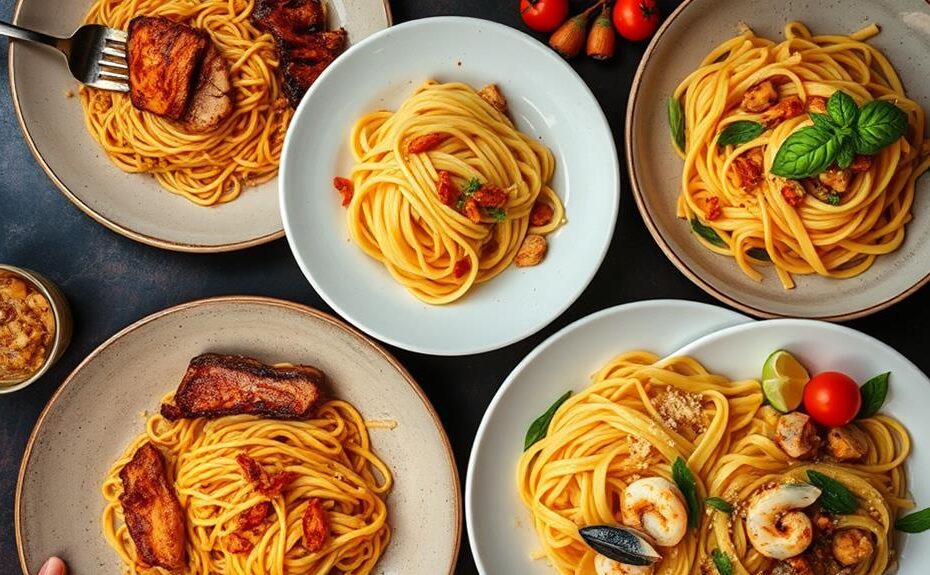Discover Unique Filipino Pasta Dishes
Filipino cuisine combines traditional ingredients with Italian pasta to create a distinct culinary experience. Pancit Bihon, a popular Filipino dish made with rice flour noodles, is a must-try.
Another classic is Filipino Hot Dog Spaghetti, which features a sweet-style hot dog and a sweet tomato-based sauce.
Sinigang Soup Noodle Variations showcase the cultural significance of Filipino cuisine, with sour broth served with various noodles.
Innovative Fusion Dishes
Filipino-Italian fusion dishes offer creative twists. Ube-Infused Pasta combines the vibrant purple yam with Italian pasta, while Sisig-Inspired Pasta incorporates the popular Filipino appetizer made with chopped pork's face into a pasta dish.
Bibingka-Influenced Coconut Pasta brings together the traditional Filipino rice cake with coconut milk and Italian pasta.
Sweet Treats and Comfort Food
Filipino pasta dishes also offer sweet treats like Halo-Halo Mixed Pasta Delights, which combines the popular Filipino dessert with pasta.
Savory comfort food fusions include Arroz Caldo Chicken Pasta Fusions, which brings together Filipino chicken and rice porridge with Italian pasta, and Lumpia-Wrapped Pasta Bites, which wraps pasta in Filipino-style spring roll wrappers.
Savory Pancit Bihon Delights
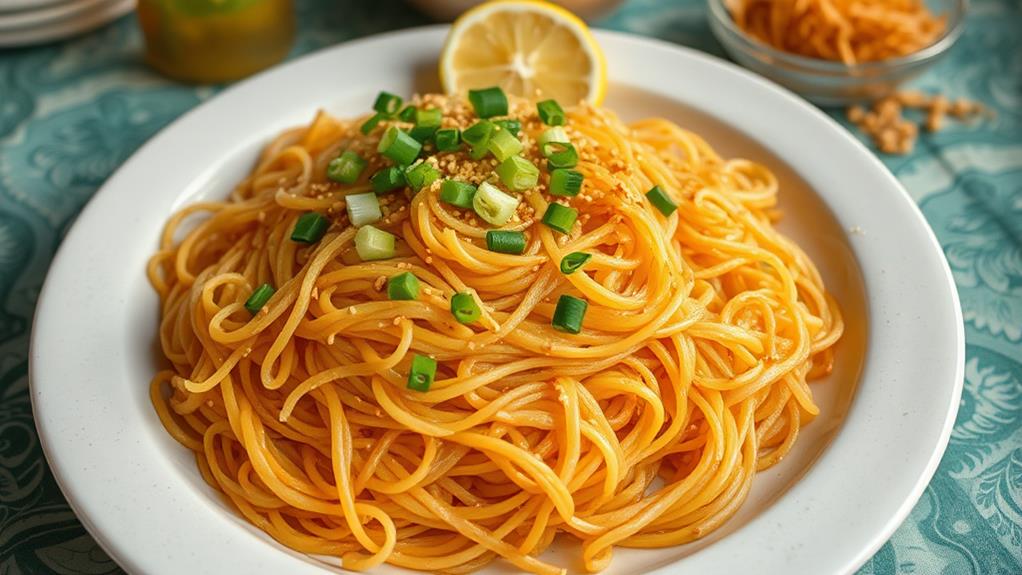
Pancit Bihon: A Savory Filipino Noodle Delight
Authentic Flavors and Texture
When you take your first bite of Pancit Bihon, the savory flavors instantly transport you to the Philippines. The dish is a masterclass in balancing flavors, with thin rice noodles stir-fried to perfection with a variety of ingredients. The savory flavor profile is enhanced by the addition of garlic, onions, and sometimes a squeeze of calamansi for a citrusy kick.
Versatile and Nutritious
The noodles are cooked just right, maintaining a slight chewiness that complements the stir-fried ingredients and sauce. The dish is incredibly versatile, allowing you to add your favorite vegetables like carrots, cabbage, and bell peppers. This not only adds color to the dish but also makes it a nutritious option.
Cultural Significance and Enjoyment
Pancit Bihon is a staple at celebrations and gatherings, symbolizing longevity and good fortune in Filipino culture. Whether you're trying Pancit Bihon for the first time or it's a childhood favorite, this Filipino noodle dish is sure to delight with its rich flavors and satisfying texture.
Spaghetti With Sweet Filipino Twist
Filipino spaghetti is a unique twist on the classic Italian dish, characterized by its sweet and sticky flavor profile. The secret to its distinct taste lies in the sweet sauce, made with banana ketchup and sugar.
What sets Filipino spaghetti apart is the combination of unexpected ingredients, including:
Ground pork or beef adds texture, while sliced hot dogs provide a burst of flavor and fun.
Quick-melting cheese adds an extra layer of creaminess, and banana ketchup gives the sauce its signature sweetness.
This blend of ingredients has resulted in a dish that's both familiar and exotic, comforting and exciting all at once.
Filipino spaghetti originated during American colonization, but it has since become an integral part of Filipino culture and identity.
Filipino spaghetti is definitely worth trying, whether you're a foodie or just curious about new flavors.
Ube-Infused Pasta Creations
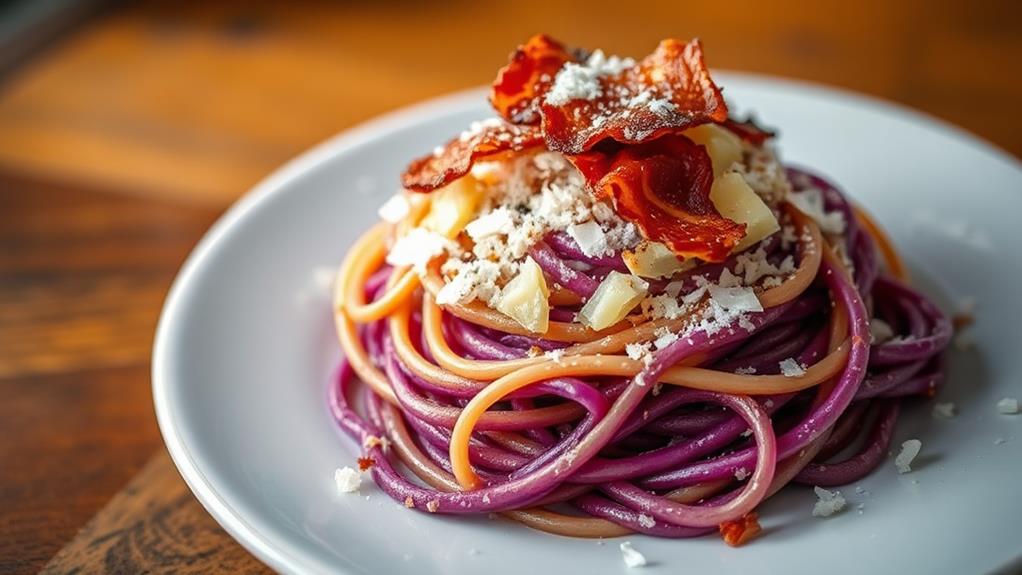
Ube-infused pasta creations introduce a unique twist to traditional dishes. By incorporating ube, a vibrant purple yam with a subtly sweet and earthy flavor, into pasta dough, the resulting noodles are visually appealing and mildly sweet. This sweetness complements savory sauces, such as Filipino-inspired creamy coconut or garlic-butter sauces.
This fusion of traditional Filipino ingredients with classic Italian cooking reflects a growing trend in Filipino cuisine, appealing to both local and international palates.
Popular recipes like ube fettuccine or ube Filipino spaghetti demonstrate this trend, with the addition of fresh herbs and cheese creating a colorful and delicious dining experience.
Ube-infused pasta creations offer a fresh take on traditional pasta dishes with a distinctly Filipino flair. By blending ube into pasta dough, the resulting dishes aren't only visually striking but also provide a unique flavor profile that sets them apart from traditional pasta creations.
Filipino Hot Dog Spaghetti Surprises
Filipino Hot Dog Spaghetti: A Unique Twist on a Classic
Filipino hot dog spaghetti defies traditional pasta dishes with its vibrant appearance and unconventional flavor profile. The combination of hot dogs and banana ketchup adds a sweet and tangy twist to the classic spaghetti.
The dish's rich flavor profile comes from sautéed ground meat (typically a mix of pork and beef) with garlic and onions. The meat sauce is then combined with banana ketchup, creating a unique harmony of flavors.
Notable aspects of this Filipino spaghetti dish include:
- The use of bright red hot dogs, which add a pop of color and distinct flavor.
- The incorporation of quick-melting cheese, such as Velveeta, for an added layer of creaminess.
- The dish's comforting appeal, often served at birthday parties and family gatherings.
- Its representation of the fusion of American and Filipino culinary influences.
Sisig-Inspired Pasta Innovations
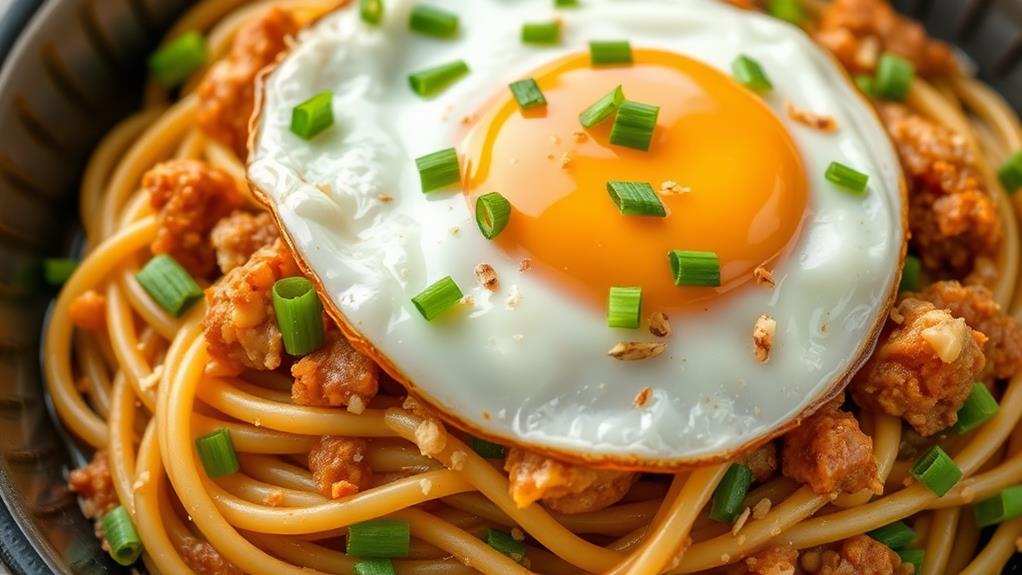
Sisig-Inspired Pasta Innovations Redefine the Culinary Landscape
The fusion of traditional Filipino sisig flavors and Western pasta dishes has given birth to a unique culinary experience. Sisig-inspired pasta innovations typically feature marinated pork head meat tossed with pasta, echoing the bold flavors of the original dish.
The Sisig Sauce: A Key Component
The sisig sauce, made from sautéed onions, chilies, and a rich, tangy marinade, is a crucial element in sisig pasta. Some recipes take it up a notch by adding a creamy element, such as a drizzle of mayonnaise or a sprinkle of cheese, reminiscent of the classic sisig presentation.
Visually Appealing and Interactive Dining Experience
Sisig pasta is often served on sizzling plates, similar to how traditional sisig is presented. This visually appealing and interactive dining experience adds to the excitement of exploring this innovative fusion.
Growing Popularity Reflects Blending of Cuisines
The growing popularity of sisig-inspired pasta reflects the trend of blending traditional Filipino cuisine with Western pasta dishes, appealing to both local and international palates.
Sinigang Soup Noodle Variations
Sinigang Soup Noodle Variations: A Fusion of Filipino Flavors
Sinigang soup noodle variations are a creative twist on traditional Filipino pasta dishes, combining the sour broth of sinigang soup with comforting noodles.
Key Characteristics
These variations are defined by:
- The use of bihon or egg noodles, which absorb the sour flavors of the broth, making the dish more filling.
- The incorporation of various proteins such as pork, shrimp, or beef, which enhance the overall taste and nutritional value.
- A rich and flavorful broth, made with tamarind, tomatoes, and vegetables like radish and bok choy, which adds depth to the dish.
- Comforting qualities, making it perfect for family gatherings and cooler weather.
Adaptability of Filipino Cuisine
These variations showcase the adaptability of Filipino cuisine, merging classic elements with modern preferences for more substantial meals.
Bibingka-Influenced Coconut Pasta
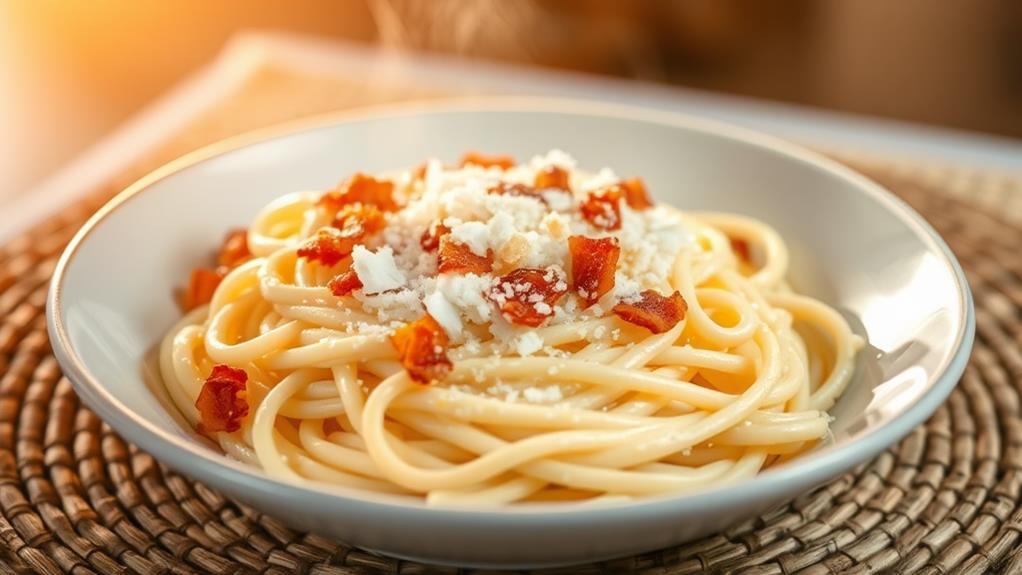
Bibingka-Influenced Coconut Pasta: A Filipino Fusion
This innovative dish combines the comforting essence of Filipino rice cakes with the heartiness of pasta. Coconut milk serves as a creamy base, enriching the texture and flavor of the dish.
Rice noodles or spaghetti are paired with grated coconut, sugar, and a hint of salt to replicate the sweet and savory profile of bibingka.
Toppings may include cheese similar to Velveeta, providing a gooey finish reminiscent of melted cheese used in traditional bibingka.
Garnishes can include slices of salted eggs and fresh herbs, mirroring the colorful presentation of traditional bibingka. This unique fusion celebrates Filipino comfort food, blending the best of both worlds.
The result is a harmonious blend of flavors and textures, making this dish a must-try.
With each bite, you'll experience the creative combination of pasta and bibingka, showcasing the versatility of Filipino cuisine.
Halo-Halo Mixed Pasta Delights
Halo-Halo Mixed Pasta Delights Redefine the Classic Filipino Dessert
Halo-Halo Mixed Pasta Delights is a creative twist on the traditional Filipino dessert, transforming it into a savory-sweet pasta experience. This innovative dish layers shaved ice, evaporated milk, sweetened fruits, and sometimes ube ice cream over cooked pasta, creating a unique and colorful meal or snack.
Key Components of Halo-Halo Mixed Pasta Delights
The combination of shaved ice and evaporated milk adds a creamy, sweet dimension to the dish, providing a rich and velvety texture.
Sweetened fruits add a pop of color and freshness, while ube ice cream brings a subtle nutty flavor.
The use of pasta as a base gives the dish a satisfying heft, making it more filling than a traditional halo-halo.
The Significance of Halo-Halo Mixed Pasta Delights
This dish showcases the adaptability of Filipino cuisine, appealing to both traditionalists and those looking for new culinary experiences.
It proves that classic desserts can be reimagined into unique and delightful meals, highlighting the creativity and diversity of Filipino cooking.
Arroz Caldo Chicken Pasta Fusions
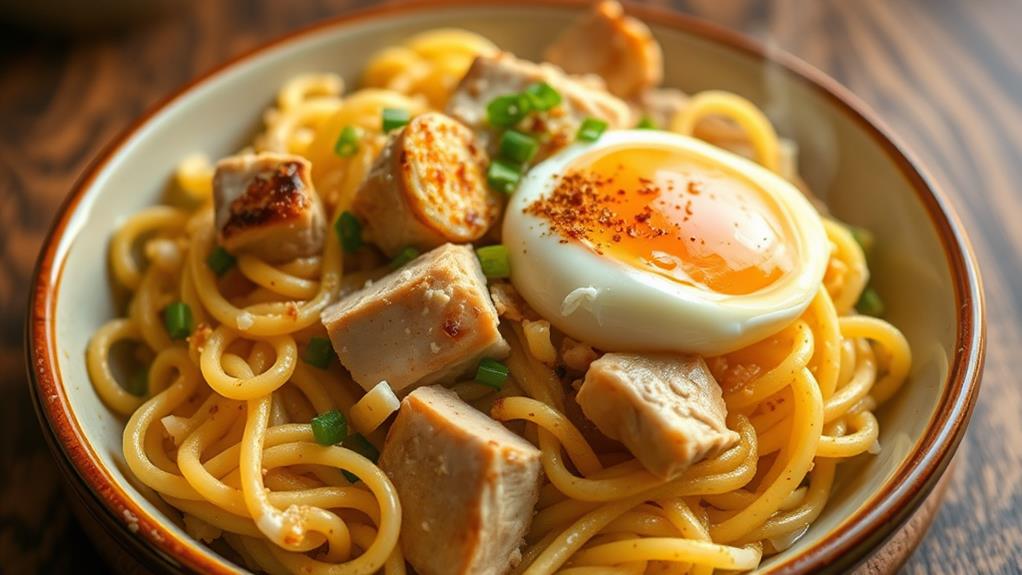
Filipino Pasta Fusions: A Creative Twist on Traditional Cuisine
Arroz Caldo Chicken Pasta Fusions combines the comforting essence of traditional Arroz Caldo with the familiar texture of pasta, creating a unique fusion meal. This innovative dish adapts the classic Arroz Caldo recipe by replacing rice with spaghetti or fettuccine, resulting in a comforting and flavorful meal.
Key Ingredients and Adaptations
| Ingredient | Traditional Arroz Caldo | Pasta Fusion |
|---|---|---|
| Rice | Simmered with chicken and spices | Replaced with spaghetti or fettuccine |
| Chicken | Cooked in broth with ginger and garlic | Retains its flavorful role in the dish |
| Garnishes | Calamansi juice and fried garlic | Add a burst of citrus and crunch to the pasta |
The Benefits of Fusion
This fusion dish not only retains the comforting flavors of Arroz Caldo but also offers a unique texture and experience for pasta lovers seeking to explore Filipino cuisine. By combining the wholesome ingredients of Arroz Caldo with pasta, you can create a satisfying meal that celebrates Filipino culinary traditions while appealing to diverse tastes and preferences.
What Makes Filipino Pasta Dishes Suitable for Quick Dinners?
Filipino pasta dishes are perfect for quick dinners because of their easy preparation and delicious flavors. With a variety of easy filipino pasta recipes to choose from, such as spaghetti with banana ketchup or carbonara with local spices, you can whip up a satisfying meal in no time.
Lumpia-Wrapped Pasta Bites
Lumpia-Wrapped Pasta Bites: A Unique Filipino-Italian Fusion
Combining Filipino Spring Rolls with Italian-Inspired Pasta Fillings
Lumpia-Wrapped Pasta Bites are a creative twist on traditional Filipino cuisine, blending the country's love for spring rolls with Italian-inspired pasta fillings. This dish showcases the versatility of Filipino cuisine, allowing for endless combinations of flavors and textures.
Pasta Versatility
The pasta used in these bites can range from classic spaghetti to other noodle types, offering versatility in flavor and texture. This means that cooks can experiment with different pasta shapes and flavors to create unique taste experiences.
Preparation and Ingredients
Typically, the lumpia wrappers are filled with a mixture of cooked pasta, meats, vegetables, and seasonings, then rolled and deep-fried for a crispy exterior. This results in a crunchy outside and a flavorful, savory inside.
Serving and Dipping
These bites are often served as appetizers or snacks at gatherings, reflecting the celebratory nature of Filipino cuisine and the love for finger foods.
Dipping sauces, such as sweet chili sauce or garlic mayonnaise, are commonly paired with lumpia-wrapped pasta bites to enhance their flavor profile and provide a delicious contrast to the crispy texture.
Experience the Perfect Harmony of Flavors
As you indulge in these bite-sized treats, you'll experience the perfect harmony of Filipino and Italian flavors, making Lumpia-Wrapped Pasta Bites a must-try at any gathering or celebration.
Frequently Asked Questions
What Is the Most Delicious Filipino Dish?
The quest to discover the most delicious Filipino dish is a challenging one. The country's rich culinary heritage offers a diverse range of flavors and ingredients, making it difficult to pinpoint a single standout dish.
Traditional Filipino ingredients like banana ketchup, ube, and adobo are staples in many recipes. Regional variations and fusion recipes further add to the complexity of Filipino cuisine.
Chicken Adobo is often cited as the most representative Filipino dish. This popular dish is a harmonious blend of vinegar, soy sauce, and garlic, showcasing the heart of Filipino cuisine.
Which Pasta Is Best in Taste?
The best pasta is a matter of personal taste.
Filipino pasta dishes offer a diverse range of flavors, from sweet and savory to umami and hearty. For example, Pancit Bihon's citrusy twist adds a unique flavor profile.
Cooking techniques, such as stir-frying, bring out ingredient pairings like soy sauce and seafood.
Cultural influences, like the use of banana ketchup, create distinctive flavor profiles.
In the end, the best pasta is the one that resonates with your taste buds.
Which Is the Tastiest Pasta in the World?
The tastiest pasta in the world is a matter of personal preference. It depends on various factors, including traditional ingredients, regional variations, cooking techniques, and fusion flavors.
Italian pasta is renowned for its rich flavors, with dishes like carbonara and amatriciana showcasing the country's culinary expertise.
In contrast, Asian noodles often boast bold fusion flavors, as seen in Japanese ramen and Korean naengmyeon.
Latin American pasta pairings frequently feature a spicy kick, exemplified by the use of chili peppers in Peruvian and Mexican cuisine.
Ultimately, the tastiest pasta is the one that resonates with your individual taste buds, so exploration and experimentation are essential to finding your perfect match.
What Is the Signature Dish of the Philippines?
Adobo is the signature dish of the Philippines. It's a unique blend of flavors, featuring a sweet and savory flavor profile that sets it apart from other dishes.
With regional variations and traditional cooking methods, adobo is deeply rooted in cultural significance. This dish is a true reflection of the country's culinary identity, showcasing the adaptability and creativity of Filipino cuisine.
In adobo, meat or seafood is marinated in a mixture of vinegar, soy sauce, garlic, and bay leaves, then slowly cooked in oil. The resulting dish is a harmonious balance of sweet, sour, and savory flavors.
Regional variations of adobo include different protein sources, such as chicken, pork, or seafood, and additional ingredients like coconut milk or chili peppers.
Adobo's cultural significance extends beyond its flavor profile. It's often served at family gatherings and special occasions, symbolizing unity and togetherness.
The dish has also been influenced by the country's history, with adaptations from Spanish, Chinese, and Malay cuisines.
